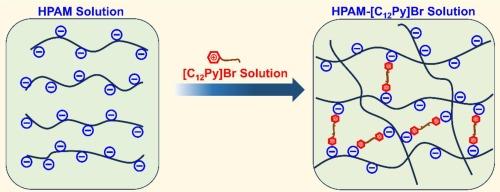长尾吡啶基离子液体介导阴离子型聚丙烯酰胺的疏水缔合行为
IF 5.2
2区 化学
Q2 CHEMISTRY, PHYSICAL
引用次数: 0
摘要
疏水缔合聚合物(HAPs)通常溶解缓慢,在水力压裂中典型的高流量、高剪切条件下表现出有限的性能。为了解决这一挑战,合成了不同烷基链长的吡啶离子液体(C8, C10, C12, C14),并与阴离子部分水解聚丙烯酰胺(HPAM)组装形成疏水相关复合流体。系统流变试验确定了最佳配方:[C12Py]Br 40 mg/L、HPAM 2000 mg/L,具有最大的粘度和优良的触变性。该复合流体表现出优异的剪切减薄和剪切恢复性能,在加热至120°C后保持了≥71%的粘度,并表现出对Na+, Ca2+和Mg2+盐的强大抗性,优于HPAM和传统疏水聚合物。此外,复合流体表现出增强的粘弹性和显著降低的表面/界面张力,这些优势在NaCl存在下进一步得到改善。这些改进归因于静电屏蔽和疏水缔合的协同效应,从而产生三维网络结构。研究结果为设计高性能增稠和减阻剂提供了一种有前景的策略,可用于恶劣井下环境下的高速水力压裂。本文章由计算机程序翻译,如有差异,请以英文原文为准。

Hydrophobic association behavior of anionic polyacrylamide mediated by long-tailed pyridinium-based ionic liquid
Hydrophobic associative polymers (HAPs) often suffer from slow dissolution and exhibit limited performance under the high-flow, high-shear conditions typical in hydraulic fracturing. To address this challenge, thepyridinium ionic liquids with varied alkyl chain lengths (C8, C10, C12, C14) were synthesized and assembled with anionic partially hydrolyzed polyacrylamide (HPAM) to form hydrophobically associated composite fluids. Systematic rheological testing identified the optimal formulation: 40 mg/L [C12Py]Br and 2000 mg/L HPAM, which possessed maximal viscosity and superior thixotropy. This composite fluid demonstrated excellent shear-thinning and shear-recovery properties, retained ≥71 % of its viscosity after heating to 120 °C, and showed robust resistance to Na+, Ca2+, and Mg2+ salts, outperforming both HPAM and conventional hydrophobic polymers. Furthermore, the composite fluid exhibited enhanced viscoelasticity and significantly reduced surface/interfacial tensions, and these advantages were further improved in the presence of NaCl. These improvements are attributed to the synergistic effect of electrostatic shielding and hydrophobic association, which yields a three-dimensional network structure. The findings present a promising strategy for designing high-performance thickening and drag-reduction agents for high-rate hydraulic fracturing in harsh downhole environments.
求助全文
通过发布文献求助,成功后即可免费获取论文全文。
去求助
来源期刊

Journal of Molecular Liquids
化学-物理:原子、分子和化学物理
CiteScore
10.30
自引率
16.70%
发文量
2597
审稿时长
78 days
期刊介绍:
The journal includes papers in the following areas:
– Simple organic liquids and mixtures
– Ionic liquids
– Surfactant solutions (including micelles and vesicles) and liquid interfaces
– Colloidal solutions and nanoparticles
– Thermotropic and lyotropic liquid crystals
– Ferrofluids
– Water, aqueous solutions and other hydrogen-bonded liquids
– Lubricants, polymer solutions and melts
– Molten metals and salts
– Phase transitions and critical phenomena in liquids and confined fluids
– Self assembly in complex liquids.– Biomolecules in solution
The emphasis is on the molecular (or microscopic) understanding of particular liquids or liquid systems, especially concerning structure, dynamics and intermolecular forces. The experimental techniques used may include:
– Conventional spectroscopy (mid-IR and far-IR, Raman, NMR, etc.)
– Non-linear optics and time resolved spectroscopy (psec, fsec, asec, ISRS, etc.)
– Light scattering (Rayleigh, Brillouin, PCS, etc.)
– Dielectric relaxation
– X-ray and neutron scattering and diffraction.
Experimental studies, computer simulations (MD or MC) and analytical theory will be considered for publication; papers just reporting experimental results that do not contribute to the understanding of the fundamentals of molecular and ionic liquids will not be accepted. Only papers of a non-routine nature and advancing the field will be considered for publication.
 求助内容:
求助内容: 应助结果提醒方式:
应助结果提醒方式:


